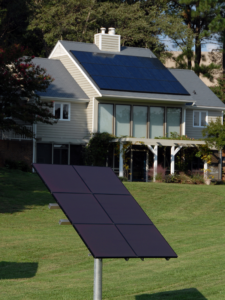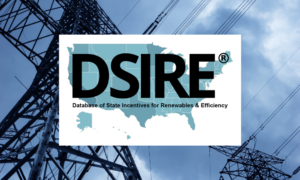35 Years of NCCETC: A Retrospective with the First Executive Director of the NC Clean Energy Technology Center
 The North Carolina Clean Energy Technology Center (NCCETC or Center) at NC State University turns 35 this year. To celebrate this milestone, we sat down with the founding Executive Director of NCCETC, Larry Shirley, to take a look back on the beginnings of the Center and see how it has grown into a state agency respected for its assistance to the burgeoning “clean tech” sector in North Carolina.
The North Carolina Clean Energy Technology Center (NCCETC or Center) at NC State University turns 35 this year. To celebrate this milestone, we sat down with the founding Executive Director of NCCETC, Larry Shirley, to take a look back on the beginnings of the Center and see how it has grown into a state agency respected for its assistance to the burgeoning “clean tech” sector in North Carolina.
NCCETC is a public service center seeking to advance a sustainable energy economy by educating, demonstrating, and providing support for clean energy technologies, practices and policies. For the last 35 years, the Center has worked closely with partners in government, industry, academia, and the non-profit community while evolving to include a greater geographic scope and array of clean energy technologies.
Shirley served as the Executive Director of NCCETC from when it was first established in December 1987 as the North Carolina Solar Center through 2000. The state government of North Carolina, NC State University, and the solar industry came together to launch the Solar Center with sponsorship from the State Energy Office in NC to meet the need for a central clearing house that could assist the state’s citizens, businesses and institutions in using solar energy.
 It All Started with Solar
It All Started with Solar
The origin of NCCETC can be found in the Solar House at NC State University which served as a showcase facility for research, education and demonstration when NCCETC was first established in December 1987 as the North Carolina Solar Center. The Solar House was originally constructed in 1981 under the leadership of principal investigators Herbert Exerlin and Al Boyers in Mechanical and Aerospace Engineering, and Ray DeBruhl in Civil Engineering
OUTREACH & EXTENSION
“When the Center first began, we were very outreach oriented,” Shirley explained. The Solar Center stemmed from a deep commitment to bringing its services and resources to people across North Carolina, making them accessible to both professionals and the general public.
According to Shirley, the Center helped facilitate the introduction of solar photovoltaic (PV) technology into North Carolina’s public marketplace. “We found that people in both urban and rural areas supported solar so we started doing workshops, conferences and events which eventually led to the Solar Communities Program,” said Shirley.
Awarded the National Environmental Achievement Award by Renew America in 1991, the Solar Communities Program extended the services and programs of the Center into selected communities across the state. In each Solar Community, the Center teamed with the county office of the NC Cooperative Extension Service to staff a steering committee of local leaders and energy professionals to guide the selection and execution of demonstration programs in their region. The Solar Communities Program began in Forsyth county in 1989 and, throughout the 1990s, programs were held in Buncombe, Transylvania, Henderson, Forsyth, Guilford, Wake, and Watauga counties.
Shirley believes there’s no substitute for a first-hand tour of solar homes and facilities. “We would host Solar Home Tours every year,” he said. Solar Home Tours enabled attendees to talk directly with homeowners, builders, architects and contractors about their solar experiences. Between 1988 and 1998, the Center led 16 tours of solar homes across the state for 2,200 people.
The Solar Information Center was another one of the original outreach programs offered by NCCETC. Shirley said, “We had a toll-free hotline to give people direct access to the Center’s team of renewable energy specialists in addition to professionals and businesses providing solar energy services around the state.” Between 1988 and 1998, the Center received more than 25,000 requests for information and technical assistance. They also provided hundreds of design reviews for builders, architects and homeowners.
From its inception, NCCETC has believed that utilities are one of the most critical components to advancing the use of PV, or solar electricity, in the state. The Center convened the NC Photovoltaics for Utilities (PV4U) Working Group in 1992, a collaborative of utilities, regulators, educators, industry and environmental groups working together to accelerate utility use and acceptance of solar PV technology.
The PV4U Working Group served as a forum for the debate of key issues, such as net metering and interconnection standards, and spawned several demonstration projects, including the 9 kilowatt (kW) PV system that was installed on the headquarters of NC Power Company in 1993. For this project and its work in convening the Working Group, the Center was given the National Renewable Energy Recognition Award by the Interstate Renewable Energy Council (IREC) in 1995.
POLICY ANALYSIS
In the policy arena, NCCETC has provided analytical, educational, and informational services on the state and national levels for state agencies, the private sector, and even international audiences. Nationally, NCCETC assisted IREC, starting in 1994, to provide technical assistance to utilities and state agencies on the value of photovoltaics. This work increasingly focused on issues surrounding the interconnection of PV systems to the utility grid, resulting in several state workshops for utility engineers and publication of the Non-Technical Guide to PV Interconnection Issues.
On a state level, the Center helped the NC Department of Revenue review the guidelines for the state tax credits and assess the potential revenue impacts of proposed changes in the credits. As an incentive to develop more solar energy, North Carolina expanded state tax credits for solar in 1994 to cover 35 percent of the installed equipment with a ceiling of $3,500.
 A major achievement during Shirley’s time at the Center was the creation of the Database of State Incentives for Renewables and Efficiency (DSIRE) in 1995. During his time working with state agencies, utilities, and regulators across the United States, Shirley saw a need for a central database of policies for policy makers to reference.
A major achievement during Shirley’s time at the Center was the creation of the Database of State Incentives for Renewables and Efficiency (DSIRE) in 1995. During his time working with state agencies, utilities, and regulators across the United States, Shirley saw a need for a central database of policies for policy makers to reference.
“I came up with the idea back in the early 90s and took it to IREC with the goal to create a national database of all state and utility programs, incentives and regulations that promote the use of renewable energy,” Shirley said. “I envisioned a central database that could be a tool for everyone.” He further explained that the partnership with IREC was instrumental in acquiring grants which originally funded DSIRE from the U.S. Department of Energy.
A combination of policy guidelines, rules and laws provide us with the tools to advance the use of renewable energy and overcome barriers to adopting clean energy technologies. In the late 1990s, the policy and incentive landscape was quite different than it is today, with only 118 state-administered financial incentives across the country in 1997.
DSIRE has grown from offering 400 state and utility incentive programs focused on renewable energy in 1998 to now include summaries of more than 2,600 incentives and policies related to renewable energy, energy efficiency, energy storage, electric vehicles, and more. Over time, the DSIRE project has become much more than a database and is recognized as the most comprehensive source of information on clean energy related policies and incentives in the United States.
RESEARCH & DEVELOPMENT
The research and testing program at NCCETC accelerated in 1995 as it began work on the evaluation and testing of building-integrated PV systems. “The system, which was designed by Innovative Design in Raleigh, performed three functions for the building: electricity generation, the capture of heat that builds up behind the solar modules to provide space heating or hot water and also served as part of the building’s outer shell,” said Shirley. Two prototype systems evaluated at the Center were later installed and monitored at an Applebee’s Restaurant in Salisbury and a Central Carolina Bank branch office in Bessemer City.
“I also received approval from NC State University to create a Solar Research Annex that could be used for research and testing programs,” Shirley added. The annex, which was adjacent to the Solar House, was used to test two prototypes of the Power Roof, a large solar thermal system for industrial applications which provides process heat, absorption cooling and electricity.
After his time at NCCETC, Larry Shirley went on to direct the State Energy Office in North Carolina for nine years. From 2009-2012, he served as the Director of the Green Economy in the North Carolina Department of Commerce. Shirley is proud of how the Center has evolved to encompass more renewable energy technologies and broaden its mission as it seeks to promote the development and use of clean energy in ways that stimulate a sustainable economy in North Carolina and beyond.
This article is part of a series highlighting the work done by the NC Clean Energy Technology Center throughout its history in celebration of its 35th Anniversary.